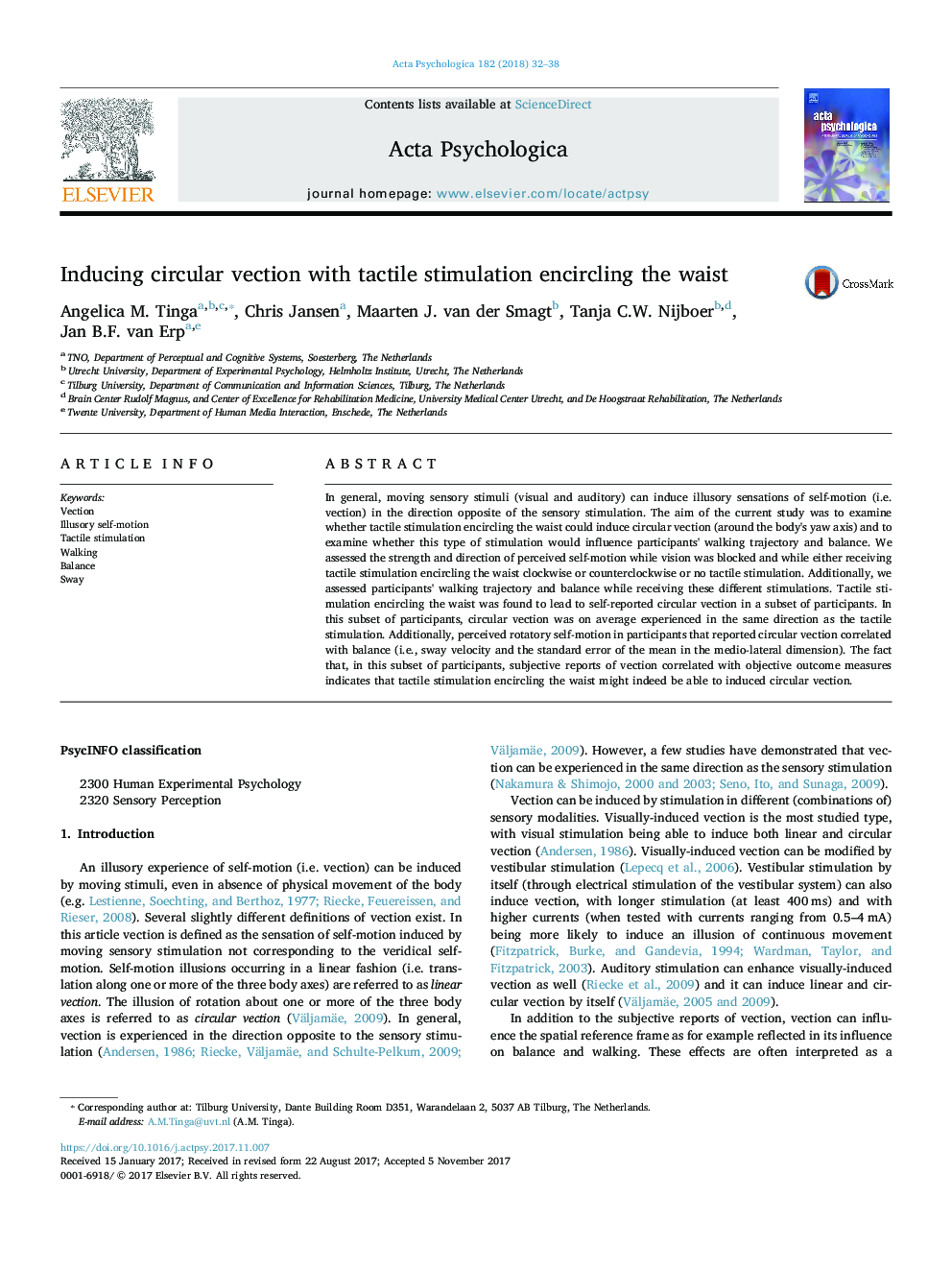| کد مقاله | کد نشریه | سال انتشار | مقاله انگلیسی | نسخه تمام متن |
|---|---|---|---|---|
| 7276849 | 1473576 | 2018 | 7 صفحه PDF | دانلود رایگان |
عنوان انگلیسی مقاله ISI
Inducing circular vection with tactile stimulation encircling the waist
ترجمه فارسی عنوان
ایجاد انگشت دایره ای با تحریک لمسی و دور کمر
دانلود مقاله + سفارش ترجمه
دانلود مقاله ISI انگلیسی
رایگان برای ایرانیان
کلمات کلیدی
ویروس، حرکت خود منزوی، تحریک تاکتیکی، پیاده روی، تعادل، نوازش کن
ترجمه چکیده
به طور کلی، محرک های حسی حرکتی (بصری و شنوایی) می توانند احساسات خیالی خود را (یعنی زخم) در جهت مقابل تحریک حساسیتی ایجاد کنند. هدف از مطالعه حاضر این بود که آیا تحریک لمسی در محدوده دور کمر می تواند زگیل دایره ای (در اطراف محور ناحیه بدن) ایجاد کند و یا اینکه آیا این نوع تحریک بر روی مسیر پیاده روی و توازن قدم زدن درون شرکت تاثیر می گذارد. ما قدرت و جهت حرکت خود را درک کردیم در حالی که بینایی مسدود شده بود و در حالی که تحریک لمسی در محدوده دور کمر در جهت عقربه های ساعت یا ضد ساعت یا بدون تحریک لمسی بود. علاوه بر این، ما در حال بررسی مسیرهای پیاده روی شرکت کنندگان و تعادل در حالی که دریافت این تحریک های مختلف. تحریک محرک در محدوده دور کمر منجر به زخم دایره ای خود گزارش شده در یک زیر مجموعه از شرکت کنندگان شد. در این زیر مجموعه از شرکت کنندگان، زخم دایره ای به طور متوسط در همان جهت به عنوان تحریک لمسی تجربه شد. علاوه بر این، خود حرکت حرکتی درک شده در شرکت کنندگان که نهایت دایره ای را با تعادل گزارش کرد (به عنوان مثال، سرعت شتاب و خطای استاندارد میانگین در ابعاد متوسطی) گزارش شده است. واقعیت این است که در این زیرمجموعه شرکت کنندگان گزارش های ذهنی ناقصی که با معیارهای نتایج عینی مرتبط است، نشان می دهد که تحریک لمسی در محدوده دور کمر ممکن است حقیقتا بتواند التهاب دایره ای ایجاد شود.
موضوعات مرتبط
علوم زیستی و بیوفناوری
علم عصب شناسی
علوم اعصاب شناختی
چکیده انگلیسی
In general, moving sensory stimuli (visual and auditory) can induce illusory sensations of self-motion (i.e. vection) in the direction opposite of the sensory stimulation. The aim of the current study was to examine whether tactile stimulation encircling the waist could induce circular vection (around the body's yaw axis) and to examine whether this type of stimulation would influence participants' walking trajectory and balance. We assessed the strength and direction of perceived self-motion while vision was blocked and while either receiving tactile stimulation encircling the waist clockwise or counterclockwise or no tactile stimulation. Additionally, we assessed participants' walking trajectory and balance while receiving these different stimulations. Tactile stimulation encircling the waist was found to lead to self-reported circular vection in a subset of participants. In this subset of participants, circular vection was on average experienced in the same direction as the tactile stimulation. Additionally, perceived rotatory self-motion in participants that reported circular vection correlated with balance (i.e., sway velocity and the standard error of the mean in the medio-lateral dimension). The fact that, in this subset of participants, subjective reports of vection correlated with objective outcome measures indicates that tactile stimulation encircling the waist might indeed be able to induced circular vection.
ناشر
Database: Elsevier - ScienceDirect (ساینس دایرکت)
Journal: Acta Psychologica - Volume 182, January 2018, Pages 32-38
Journal: Acta Psychologica - Volume 182, January 2018, Pages 32-38
نویسندگان
Angelica M. Tinga, Chris Jansen, Maarten J. van der Smagt, Tanja C.W. Nijboer, Jan B.F. van Erp,
